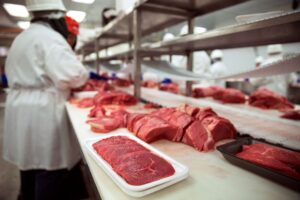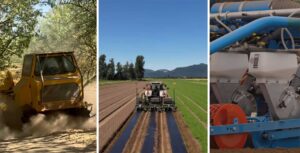Subscribe to Updates
Get the latest agriculture news and updates directly to your inbox.
Author: staff
For generations, livestock shows and fairs have brought farmers, ranchers, and rural communities together to exhibit their best livestock and compete for coveted purple banners. Yet, over the decades as cities grow outward and surround many of these historic venues, organizers and exhibitors are increasingly confronted with safety and security concerns. Every year, I hear of families who report thefts of expensive equipment — from blowers and show supplies to trucks and trailers — at state and national shows in major urban centers. Few mornings start worse than discovering that an essential tool, or even a vehicle, has disappeared overnight. …
By Leah Douglas and Cassandra Garrison WASHINGTON, Sept. 25 (Reuters) – U.S. Agriculture Secretary Brooke Rollins on Thursday said Mexico has not adequately enacted protocols to curb the spread of New World screwworm, a sign of tension between the two countries as they navigate the northward march of the pest. Rollins blamed a recent screwworm detection less than 70 miles (113 km) from the U.S. border on Mexico’s failure to curb cattle movements and inadequate monitoring of fly traps meant to reduce the wild population of screwworm flies, which infest and can kill livestock if untreated. Screwworm has not yet crossed the U.S. border,…
U.S. Rep. Haley Stevens, a Michigan Democrat, has long voiced discontent with the nation’s Health and Human Services secretary. Now, citing “absurd conspiracies, putting lives in danger, and raising healthcare costs,” Stevens said she is wanting to do something tangible about it and announced she is drafting the paperwork to impeach Robert F. Kennedy Jr. Kennedy has long been a divisive figure both in agriculture and in the broader health sector. Most recently, he was the architect behind the effort to place the blame on acetaminophen, commonly sold under the brand name Tylenol, for cases of autism in the United…
By Maximilian Heath BUENOS AIRES, Sept. 25 (Reuters) – Argentina’s declared soy exports for the 2024/25 season hit a seven-year high after a brief pause in export taxes triggered a trading frenzy, which should continue to boost the market as many exporters declared sales before buying the goods. Argentina is set to export 10.5 million metric tons of soybeans from this season’s harvest, according to government data, ahead of the previous record of 10.1 million achieved in 2018/19. Available official records go back to 2017/18. The Agriculture Secretariat did not immediately respond to a request for comment on whether this season’s declared soy…
By Wesley Muller Federal officials have not yet made public the list of hazardous materials present at a Tangipahoa Parish petroleum products plant that caught fire and exploded last month, saying that doing so might reveal “confidential business information.” The Environmental Protection Agency, which has led disaster response efforts and all public communications since the Aug. 22 incident, has known for weeks which specific hazardous and radioactive materials were present at Smitty’s Supply Inc. in Roseland. After the Illuminator repeatedly requested information about the materials, the EPA acknowledged it had such a list but refused to provide a copy, saying the agency…
BEIJING, Sept. 25 (Reuters) – The United States should remove what China described as unreasonable tariffs and create conditions to expand bilateral trade, a Chinese commerce ministry spokesperson said on Thursday when asked if China would purchase U.S. soybeans. China, the world’s biggest buyer of soybeans, has yet to book any U.S. soybean cargoes from its autumn harvest, traders have said, opting for South American supply instead. U.S. farmers stand to miss out on billions of dollars of soybean sales because of unresolved trade tensions that have halted exports to China. Senior Chinese trade negotiator Li Chenggang on Monday met political and…
At the market close, December corn was up 1½¢ at $4.25¾ per bushel. November soybeans were up 3¼¢ at $10.12¼ per bushel. “Corn, soybeans, and wheat spent much of the day session in positive territory as light buying surfaced in the commodity complex,” said Karl Setzer, partner with Consus Ag Consulting. “News that Argentina was reinstating its export taxes after reaching its sales cap of $7 billion was reached. Reports indicate China booked 35 Argentine soybean vessels over this period.” December CBOT wheat was up 7½¢ at $5.27 per bushel. December KC wheat increased 5½¢ at $5.12¼ per bushel. December…
By Paul Hammel LINCOLN – An updated report on the impact of climate change in Nebraska says the state continues to get noticeably warmer and wetter. The legislatively ordered report also concludes that predictions made in the last State Climate Report in 2014 — that the state was headed toward a climate more like Oklahoma — were spot on. The 312-page report, authorized by the Nebraska Legislature in 2022 and submitted on Wednesday, predicts increased stress on the state’s water resources, particularly increased irrigation demand as growing seasons expand and more water evaporates from the soil and crops. “Nebraska stands…
The U.S. Drought Monitor for the past week showed a mix of drought degradations and improvements. Precipitation fell across the Plains, Midwest, and mid-South, mostly from the central Rockies to the western slopes of the Appalachians, according to the U.S. Drought Monitor. The Southwest also received locally significant showers that triggered flash flooding. Mostly dry weather prevailed in the Northwest, Intermountain West, Deep South, and along the Atlantic Coast. Map of the U.S. showing drought conditions. Midwest Map of drought severity in the Midwest. The Midwest received rainfall that brought a mix of improvements and setbacks. Heavier precipitation was observed…
Pop quiz: Where did cattle ranching start in the United States? Cattle were brought to North America with early European settlers, but where? And when? If you’re thinking New England, or maybe Texas, those are good guesses. Both the Pilgrims and the Conquistadors brought cattle with them into those areas in the early 1600s. But, both are wrong. Nearly 100 years before those early settlers herded cattle in what is now the U.S., there were already cowboys and cowgirls in … Florida! Seminoles Native Americans began raising cattle in the 1520s, just 30 years after Columbus first sailed to the…








:max_bytes(150000):strip_icc()/54600485449_bfb49767a8_o-49a7f43111d9451f9076b930e5964d8c.jpg)

:max_bytes(150000):strip_icc()/BrazilShip-47c1b2083078457da5cd89ef8a6c29b2.jpg)
:max_bytes(150000):strip_icc()/5C5A8026-d8635570345f46c4933899f3e5bb960a.jpg)
:max_bytes(150000):strip_icc()/8293232288_8da55cc72e_o-b324a9331b0a48b487dd867154d53c50.jpg)
:max_bytes(150000):strip_icc()/Markets-10-Corn-up-soybeans-up-10-cb941d614a82452abc6768a865877543.jpeg)
:max_bytes(150000):strip_icc()/ScentralNEcorn1025-f50f3c8d587d4dbab8faf345e1e938ac.png)
:max_bytes(150000):strip_icc()/SoybeanHarvestSunset-CloseUp-2000-00635693505f4244b6069a6e52650657.jpg)
:max_bytes(150000):strip_icc()/FloridaCrackerCattle-1-40a331e79a7b4363bee2cd5de404a0a0.jpg)